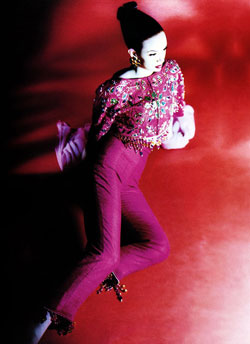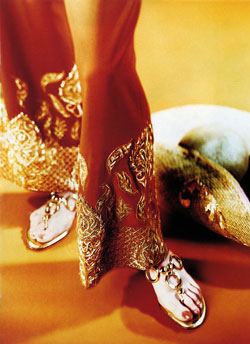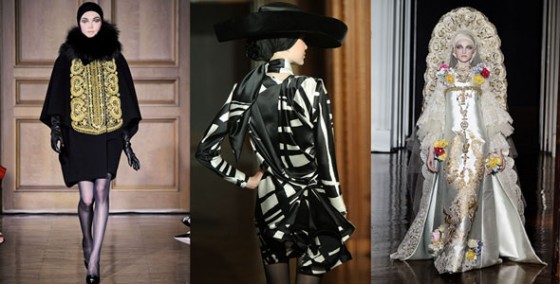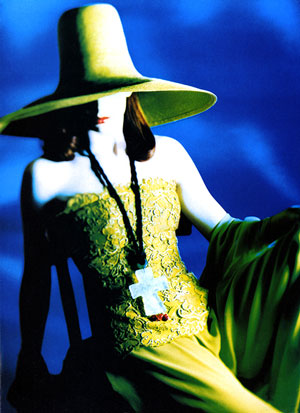Last week, I was approached by Elizabeth Day a writer for “The Observer” review, part of the Guardian group. She read my post on the Benjamin Kanarek Blog about Haute Couture and found the angle unusual enough to ask to interview me regarding the bankruptcy of the Fashion House Christian Lacroix.
She came to Paris from London for a day of marathon interviews. She started with Didier Grumbach (Président de la Chambre Syndicale de la Couture Parisienne and former President of Thierry Mugler Couture), Couturier Anne Valerie Hash, newcomer officially recognized as Couturier Stéphane Rolland and myself.
We met for an hour at The Costes, close to Place Vendôme. She asked me to explain my analysis of the situation as far as Couture is concerned. I will not paraphrase what she wrote in her article but I feel it is important to add another vantage point, that I feel is essential to understanding how the Christian Lacroix Fashion House came to it’s untimely end.
Here are three examples of paths taken to successful couture stories:
– Here are some of the post 2ndWW Historic Fashion Houses who have been running Couture Collections for decades and are still doing so: Christian Dior, Givenchy and Chanel, Valentino. Yves Saint Laurent was part of this group but Mr. Saint Laurent decided to close the Department when he retired. Their Couture sector has existed for decades bolsted by their diversified activities that are their bread and butter profit makers (ready-to-wear, accessories, cosmetics). In that time frame, where everything was possible, they were not confronted with the economic pressures of today and could afford to “Play”.
These design houses were using Couture as their Research & Development Departments. They did not look for profitability in their specific department, but at the bottom line for the overall brand. The major profits were made by their other lines that were and still are manufactured as “licensed products” which have been inspired by the “Haute Couture” (akin to Formula One Race Car Design) which is at the apex of the pyramid of creativity.
– Newcomers like Jean Paul Gaultier, Armani Privé, and Atelier Versace (who did not present recent shows) who have launched their activities at the end of the 70’s and expanded during the 80’s and 90’s and were able to develop a Haute Couture activity afterwards. For example, Gaultier Paris, the Couture line of Jean Paul Gaultier was launched in 1997 after an amazing commercial success with his perfumes respectively launched in 1993 and 1995 “Classique” and “Le Mâle” who were and still are major big movers in the industry. In this case, it was the perfume royalties that allowed him to launch his Couture Collection.
– Smaller entities Adeline André, Anne Valerie Hash, Dominique Sirop, Franck Sorbier, Maurizio Galante, Stéphane Rolland actually make a living uniquely from Couture. Some of them have ready-to-wear collections. I would classify them as tighter artisanal units or organizations who have a strong base of loyal clients The economy is even tougher for them as they have only a single source of revenue. They cannot afford advertising and are rarely supported by the editors of glossy magazines. Therefore their visibility is minimal in the fashion and celebrity world. That is where maybe Internet and the blogosphere will be a real opportunity for them.
I didn’t include Christian Lacroix as part of my classification. One of the reasons he did not survive after 22 years of being at the forefront of innovation and creativity is that he did not have his own well defined niche. Christian Lacroix launched his first perfume “C’est la Vie” in 1988. “C’est la Vie” was supposed to sustain his Couture activity, but unfortunately it was a major flop. 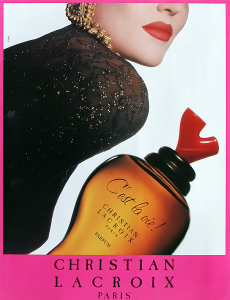 We can always speculate as to why it did not succeed. However, what we do know is that Christian Lacroix hated the final product. “C’est la Vie” was developed by the Marketing Team at Christian Dior (They were both part of the LVMH Group). In my opinion Christian Lacroix never completely recovered from this devastating blow. There were subsequent relaunches of other lines through other companies, however none of them were sufficiently successful to make up for the effect of his first launch debacle. Had the launch been a major success, I am certain that Christian Lacroix would not be in the unenviable position he is today.
We can always speculate as to why it did not succeed. However, what we do know is that Christian Lacroix hated the final product. “C’est la Vie” was developed by the Marketing Team at Christian Dior (They were both part of the LVMH Group). In my opinion Christian Lacroix never completely recovered from this devastating blow. There were subsequent relaunches of other lines through other companies, however none of them were sufficiently successful to make up for the effect of his first launch debacle. Had the launch been a major success, I am certain that Christian Lacroix would not be in the unenviable position he is today.
Here is Elizabeth Day’s article from “The Oserver”, Sunday 6 December 2009
Recession’s cold winds ruffle Paris empire of fashion
It remains to be seen whether the 14 other haute couturiers in Paris follow Rolland’s example. But Hash says it is too early to say haute couture is in terminal decline. “I’m not afraid we’ll lose haute couture altogether. There will always be a demand for beautifully hand-made, one-off pieces. It is like gastronomy – you don’t want to eat the best food every day because it’s too heavy, but you do want to have it for a special occasion.”
As economic gloom dims the glitter of French haute couture houses – with Christian Lacroix in the hands of administrators – top designers must adapt to a changing industry to survive
Christian Lacroix, who came to epitomise the essence of couture, leads out a model in one of his typically extravagant gowns at this year’s Paris autumn/winter fashion show.
Outside the Christian Lacroix shop on Paris’s fashionable Rue du Faubourg Saint Honoré, two middle-aged American tourists are debating whether to take a photograph. “It might not be here much longer,” a woman says to her husband as she takes a quick snap of the façade before moving on.
Inside, the shops are full of opulently designed clothes – a gold brocade jacket has a price tag of €2,790 (£2,500) – but they are devoid of customers. Next door, a pharmacy is squeezed incongruously between the high-end designer boutiques, its window displaying boxes of Band-Aids. Looking at the shops side-by-side, one cannot help but be struck by the thought that the Lacroix label needs more than a sticking plaster to save it.
Last week, after six months in administration amid a desperate search for a buyer, the Lacroix fashion house was made to abandon its haute couture and ready-to-wear lines as part of a restructuring plan approved by the Paris commercial court. Over the 22 years during which he had been in business, Lacroix, one of France’s best known designers, had never turned a profit. Instead he ran up losses of almost €10m (£9.05m) and owes a further €44m (£39.8m) to suppliers and the Falic Group, the duty-free retailer that bought the company in 2005. The restructuring will license out the Lacroix name for the sale of perfume and accessories, with a workforce of a dozen, reduced from 124.
“Lacroix embodied the brilliance of our country,” said France’s industry minister, Christian Estrosi, when the news was announced, and indeed Lacroix’s flamboyant designs and dazzling colours – made famous in the UK by Edina in the sitcom Absolutely Fabulous – seemed to epitomise the very essence of couture. His clothes were over-the-top, indulgent and, most importantly, had the priceless cachet of being unique.
Although the collapse of the fashion house was greeted with sadness in the highest echelons of the couture world, it was not entirely unexpected. The demise of this once mighty establishment reflected a far deeper malaise within a highly secretive industry struggling to cope with changing times. Global recession has seen a worrying downturn in the fortunes of Paris’s haute couturiers.
The price of an haute couture dress, hand-made to a client’s specification, starts at about €20,000 (£18,100). It is a luxury reserved only for the very rich and there are estimated to be fewer than 500 buyers worldwide. In recent months, with personal fortunes haemorrhaging, these customers are far less willing to spend such vast sums.
“There are fewer clients,” admits Anne Valérie Hash, one of the new generation of French haute couture designers. “When their husbands lose millions on the stock exchange, you find that women won’t buy 10 dresses, they’ll buy one.”
There are few signs, however, of belt-tightening in the headquarters of the haute couturier Stéphane Rolland. In a spacious room overlooking the Avenue George V, Rolland leans back on a vast brown leather sofa and surveys his empire. We are surrounded by rails of exquisite dresses, each painstakingly hand-sewn and adorned with a final flourish of pleats or sequins. On the black-lacquered table in front of us, there is a three-tier tray of gold-wrapped biscuits for the delectation of private clients. A uniformed butler brings us glasses of iced water, placed carefully on a folded napkin to avoid marking the table.
Rolland is a relative newcomer to the esoteric world of haute couture – he set up his label two years ago – but he is already one of the most commercially successful. He has between 80 to 100 regular clients, including Queen Rania of Jordan and Cheryl Cole, who wore two of his dresses recently on The X Factor. The majority of his clients come from emerging economies in the Middle East. “I’m telling you, inside their abayas, these girls wear the most sophisticated clothes in the world,” he says. “I can finance a whole season by doing three weddings in Saudi Arabia.”
The recession is still having an effect even here. “In terms of quantity of orders, I have a bigger amount but at smaller prices,” he says. A Stéphane Rolland creation can take 200 hours to make and starts at around €50,000 (£45,000) but he has cut his prices by 20%. “In general, there is a change because of the recession. For the first time, I’ve noticed some of my clients now pay in instalments because they are frightened of what they see on the television.”
Outside the luxury bubble, the problems facing the high-end fashion industry have broader repercussions too. The “haute couture” appellation is tightly regulated by French law and has formal guidelines that specify that a house must employ at least 15 people full time. At present there are only 15 members of this exclusive club, each relying on a small army of artisans and seamstresses (the so-called petites mains or little hands) to meet exacting standards.
“If you want to have a good name, your product has to be perfect,” says Rolland, who employs 20 seamstresses. “You cannot sell a dress for €20,000 unless it’s perfect. Haute couture is a special label, it has a special spirit.”
But the influence of the petites mains is declining. The slowing sales have had knock-on effects in places such as Caudry, a town of 14,000 people in northern France that is home to 10 lacemakers, including two of the world’s biggest weavers for haute couture. About 13% of the 800 lace-making jobs in Caudry disappeared in 2008 and more will go this year. According to the French national statistics agency, the number of small businesses serving the high-end fashion industry has shrunk from 468 nine years ago to 115 in 2007.
As if to prove a point, she slides a tray of hand-made French chocolates towards her and pops one in her mouth. Some indulgences, it seems, will never go out of fashion.”
“I’m sad when I see that artisanship is going to die,” says Hash. “All that tradition is going, and once it’s lost it’s lost for ever. To think of Paris losing haute couture is like saying London will no longer have Savile Row. It is our national pride.”
Christian Lacroix Haute Couture 2010 – photo © Marcio Madeira
Some of the bigger houses are buying up workshops to guarantee the future of their artisans. Chanel has bought six that no longer have heirs to run them, including Lesage, France’s oldest embroidery producer, but smaller houses are struggling. For Harriet Quick, the fashion features director for British Vogue, such specialised craftsmanship gives the haute couture industry its intangible appeal. “On the one hand, you can say, ‘This is mad, how can you spend so much money on a dress?’ But actually how can you criticise such a display of craftsmanship? It takes years to learn. You could apply the same equation to the car industry – ‘Why bother making this beautiful Aston Martin?’ – but it’s the kind of argument you very rarely hear.”
Across the road from the Christian Lacroix shop on Rue du Faubourg Saint Honoré, a modest plaque on the wall of a townhouse marks the headquarters of the Fédération Française de la Couture, the governing body of the French fashion industry. It does not look much from the outside but it is here, from his small, untidy office on the third floor, that Didier Grumbach, the federation’s president, decides which designers have reached the necessary standards to be awarded the prized haute couture label.
“Haute couture is essential to France,” says Grumbach. “It is a difficult time, but we have a tradition and we must preserve it.” For a man who prides himself on being a standard-bearer for French fashion, it seems strange that Grumbach is wearing a suit by the Japanese designer Issey Miyake. “Today we live in a world with no frontiers,” he says, a touch shamefacedly. “We have to survive in a globalised market.”
In fact, haute couture has a history of cross-cultural pollination. Although the industry is inextricably linked to France, it was the idea of an Englishman, Charles Frederick Worth, who revolutionised the dress-making world in mid-19th-century Paris by asking his customers to select from a portfolio of designs that would then be altered to suit their specific requirements. Worth’s methods set the foundation for the fashion houses of the future, including Lanvin, Chanel, Dior, Balenciaga and Givenchy.
The postwar period was the heyday of haute couture, when women would travel to Paris several times a year to be fitted for their wardrobes. Later, it became the preserve of socialites, including Jackie Onassis and Elizabeth Taylor. Through the 1980s, fashion designers would use their haute couture work as a means of showcasing their brands, attracting more customers through the sheer artistry of their catwalk shows.
“Haute couture is a laboratory of ideas,” explains Quick. “It’s a fantastic advertisement for a designer, it throws their image out there and helps encourage loyalty to the other parts of the brand.”
But, increasingly, it loses money – as Hash says: “I communicate with my haute couture but the margins are terrible.”
Haute couturiers have found themselves even more marginalised by the popularity of ready-to-wear clothes, most of which are mass-produced in factories in China and India. According to Gumbrach, a modern fashion house must therefore be “multi-platform” and seek to make enough money from ready-to-wear lines to subsidise the haute couture end. “More and more ladies do not want to wait weeks for a dress,” he explains. “They will buy on impulse and only buy haute couture for an extraordinary occasion, like a wedding. Without ready-to-wear, a designer will never be rich.” The problem with Lacroix, says Grumbach, is that it was a badly structured company emphasising extravagance rather than the bottom line. “Haute couture is not art. It is a business.”
Tales of Lacroix’s extravagance abound: he had more than 100 seamstresses working in his atelier and once paid for The Gipsy Kings to serenade him while he did client fittings. “He didn’t want to be bothered with the business,” says one designer. “He was arrogant. His attitude was ‘I’m an artist, I can’t be limited by financial concerns’, and he refused to move with the times.”
The key, says the fashion blogger Frédérique Renaut, is for labels to diversify, producing perfume, accessories and a ready-to-wear line under their brand name in order to generate the necessary profits to take a risk with haute couture.
The era of limitless creative freedom and glorious excess is coming to an end. The world of high fashion now faces having to reshape itself into something altogether less rarefied and more profit-driven in order to survive.
“I was one of the first designers to take the plane and fly out to the Middle East to my clients to see where they live and what their lives are like,” says Rolland. “The time when a designer could sit in a beautiful ivory tower is finished. A designer has to think about profit.”
Here is the link to read the original article by Elizabeth Day
His last Haute Couture show in July 2009…
Fashion photos of Christian Lacroix Couture from the archives of Benjamin Kanarek

